Traditional Braces - San Juan Capistrano, CA
A Proven Path to Straighter, Healthier Teeth
Misaligned teeth can lead to a wide range of issues like headaches, difficulty chewing, uneven dental wear, TMJ problems, and neck pain. Thankfully, traditional metal braces are a tried and proven orthodontic method that can straighten out teeth so a patient can enjoy a lifetime of improved oral and overall health. Here’s a brief guide to how traditional metal braces work, but please contact the staff at Platinum Dental Group if you have any questions.

Why Choose Platinum Dental Group for Traditional Braces?
- Skilled and Experienced Dentist
- Enjoy a Healthier and More Beautiful Smile
- Financing Options Available
How Do Traditional Braces Work?
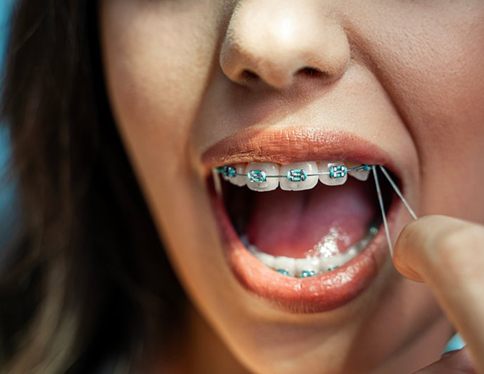
Orthodontic issues can leave teeth more vulnerable to injury and decay and cause undue stress to the TMJ, which can lead to pain in the head, jaw, neck, and back. Traditional braces realign smiles shifting teeth into healthier positions through a system of brackets with a wire running through them. Patients will need to practice excellent oral hygiene and appliance maintenance while returning to our office every six to eight weeks for checkups and adjustments. Treatment typically takes one to three years, and the results can help a patient chew comfortably and smile beautifully for life if they wear their retainer as instructed.
What Orthodontic Issues Can Braces Fix?
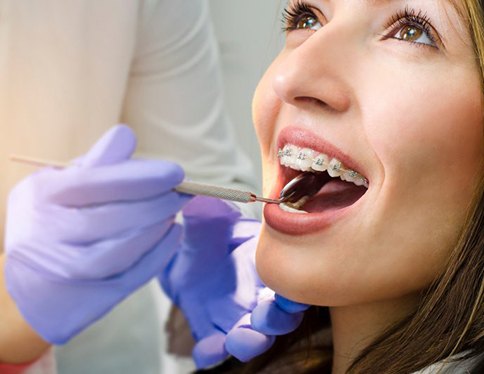
Traditional metal braces can address a wide range of alignment issues, and the best way to learn more about how these appliances can help you is to schedule a consultation with Dr. Omrani. He may recommend this treatment to address problems like:
Bite Misalignment
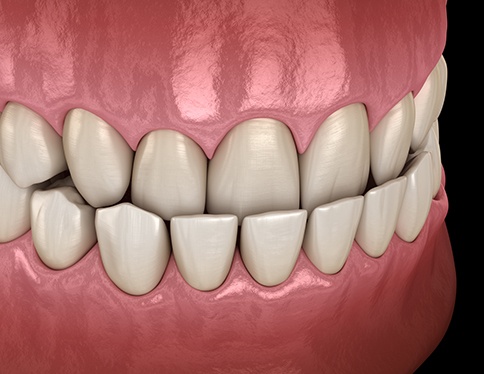
Alignment issues such as overbites, underbites, open bites, and crossbites can make chewing difficult and lead to imbalances in the TMJ, which can cause neck, head, jaw, and back pain as well as teeth grinding. Braces can address this issue by gradually pulling teeth into more optimal positions.
Crowded & Crooked Teeth
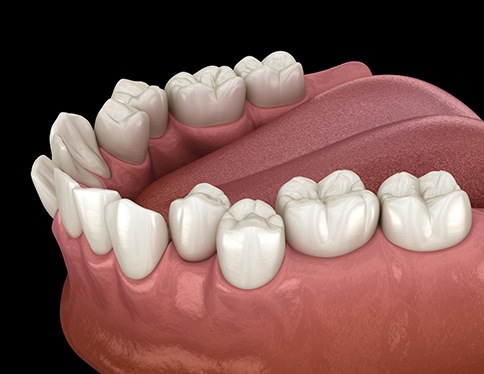
Crowding and crookedness can leave teeth harder to clean and easier to injure, and they can also lead to uneven dental wear. Traditional braces can straighten out teeth so they can chew more evenly and create a more visually pleasing smile.
Gapped Teeth

Many people find the gaps in their teeth to be unflattering, and they can even lead to accumulations of food debris or leave the gums vulnerable to injury. Traditional braces can pull gapped teeth together to create a stronger and more beautiful grin.
Understanding the Cost of Traditional Braces

When it comes to traditional braces, there’s no such thing as a one-size-fits-all treatment plan. The orthodontic process will look slightly different for each patient; naturally, this means that the overall cost of traditional braces can vary from case to case. To help you prepare ahead of time, here is a closer look at the factors that can influence the amount you pay for braces as well as your options for making the cost more manageable.
Factors That Affect the Cost of Traditional Braces
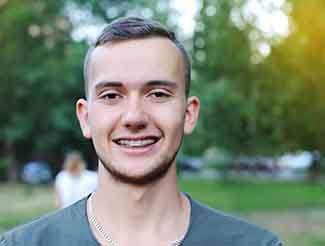
At your initial consultation, our team will thoroughly examine your teeth to learn more about your orthodontic needs. Then we can give you an estimate of what the cost of your care will look like based on a variety of factors, such as:
- Whether the orthodontic treatment will involve one or both arches of teeth.
- The nature and severity of your specific misalignment problems.
- Whether any orthodontic accessories (such as rubber bands) might need to be used in addition to traditional braces.
- How long your orthodontic treatment is expected to take.
Professional Braces vs. "DIY" Braces: Which Costs More?

You may have seen people singing the praises of do-it-yourself braces on social media, but this approach can come with serious drawbacks. Without a trained professional overseeing the process, a do-it-yourself orthodontic treatment can ultimately lead to even more severe alignment issues.
It’s generally better to have braces placed by a professional if you want the best chance of everything going as planned. Furthermore, professional braces have been clinically tested and have been proven to be highly reliable; you can count on them to help make all kinds of corrections to your smile.
Does Dental Insurance Cover Braces?

Many dental insurance plans do provide some level of coverage for braces. However, the specifics of said coverage can vary depending on your insurance carrier. For example, some plans may only help pay for orthodontic treatments for patients under the age of 18.
If you’re not completely sure whether you can use your dental insurance plan to help pay for braces, give your insurance carrier a call to clarify your benefits. Alternatively, our team can review your policy with you and clarify any details that you might be uncertain about. We can also file your claims for you and help you figure out the best way to maximize your benefits.
Options for Making Braces Affordable

If you’re looking for ways to make braces more affordable, it’s worth asking our team about signing up for our in-house membership plan. In exchange for a one-time lifetime activation fee as well as subsequent monthly fees, you can enjoy discounts on a wide variety of treatments. Alternatively, we also provide the option of applying for financing through CareCredit and Lending Club, allowing our patients to pay for their care in monthly installments instead of all at once.
Caring for Your Braces

While wearing braces, you’ll have to adhere to a strict regimen of oral hygiene and appliance maintenance. This includes thoroughly brushing and flossing several times a day while using specialized tools to clean around your braces and keep your gums stimulated. You’ll also need to avoid chewy and crunchy foods that can damage your appliances, and it will be essential to see Dr. Omrani for checkups and adjustments every six to eight weeks.
Traditional Braces FAQs
Am I Too Old to Get Braces?
Since children, teens, and young adults are often seen wearing traditional braces, you might assume that the ship has sailed on having straight teeth if you are in your 40s, 50s, or 60s. The truth is that there isn’t an upper age limit! In other words, there’s no such thing as being “too old” for braces. Factors that determine whether or not you’re a candidate include the health of your smile, the severity of your case, and your willingness to break bad habits, like smoking.
How Long Do Traditional Braces Take?
Usually, patients wear traditional braces for 1-3 years. However, the length of your treatment plan will depend on a few factors, including the severity of your case. The good news is that we can provide you with an estimate at your consultation. If you choose to move forward, we will also share what to do (and what NOT to do) to avoid frustrating delays.
What Can You Not Eat with Traditional Braces?
In an effort to prevent broken brackets, loose wires, and other orthodontic emergencies, patients are asked to avoid certain foods, like hard pretzels, tortilla chips, popcorn, and whole apples. During your teeth-straightening journey, we strongly recommend incorporating nutrient-dense foods into your diet that are softer in consistency, like cottage cheese, bananas, oatmeal, and plain yogurt. Not only will this reduce your risk of an orthodontic emergency, but it will also help keep your smile healthy from the inside out.
Can You Drink Coffee with Traditional Braces?
Now that you know about a few of the dietary restrictions, you might be wondering if there are any other rules you need to be aware of, like “no coffee.” Don’t worry – you don’t have to give up this caffeinated beverage during the teeth-straightening process. You do, however, need to take certain precautions to help prevent dental discoloration (i.e., using a straw, rinsing your mouth with water afterward, brushing your teeth 20 minutes after you’re done).
What Happens After You Get Your Braces Off?
During your orthodontic treatment, we’re focused on moving your teeth and bite into proper alignment. When it comes time to remove your braces, our focus moves to keeping them there. This is referred to as the “retention phase,” and it’s important because upwards of 50% of patients experience orthodontic relapse in the years following their time with braces.
To prevent your teeth from drifting out of place in the months and years following your orthodontic treatment, we will provide you with a custom retainer. We’ll give you instructions on when to wear it and how to take care of it so you enjoy your hard-earned results and don’t need to replace it within a matter of weeks.
Do Traditional Braces Hurt?
Of course, one of the most asked questions about traditional braces is, “Will it hurt?” To be honest, it’s normal to experience some pressure and soreness as your teeth move, especially toward the beginning of your orthodontic treatment. Fortunately, there are several ways you can alleviate any uncomfortable symptoms that do arise, like avoiding crunchy foods, sipping on cool water, and taking OTC pain medication as directed.
